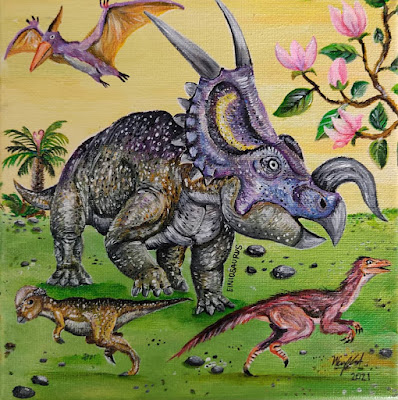Collection: Jurassic Jam-Pack
JURASSIC JAM-PACK
Dinosaurs throughout the Mesozoic era come in various shapes and sizes, from small theropods the size of turkeys to large herbivores bigger than a school bus. Dinosaurs evolved a wide range of forms to fill in various ecological roles which are similar to the natural world today. The assortment of the unique families of dinosaurs made the Dinosauria a very interesting group for scientists and popular culture to tap into.
Jurassic Jam-Pack, acrylic on canvas, 2021. Set of 9, each piece 8" X 8"
Amargasaurus
Amargasaurus, acrylic on canvas, 2021
Amargasaurus is a member of the long-necked sauropod family which lived in Argentina during the early Cretaceous period. It is famous for a double row of tall spines running across its long neck. These spines might have been used for display, combat, or defense. The small carnivore in the painting is Ligabueino, a member of the noasaurid family of theropods.
Carnotaurus
Prowling Carnotaurus, acrylic on canvas, 2021
Carnotaurus is a carnivorous theropod dinosaur which lived in South America during the late Cretaceous period. It had two bony, horn-like structures on top of its head. This dinosaur had one of the smallest pairs of arms among theropod dinosaurs. Its skin is covered in a mosaic of hard scales and large bony bumps called osteoderms.
Einiosaurus
Einiosaurus, acrylic on canvas, 2021
Einiosaurus (meaning "buffalo lizard") is a horned dinosaur which is known for its large nose horn which curved forward like a can opener. It is a member of the ceratopsian (horned dinosaur) family and lived in North America during the late Cretaceous. Two smaller dinosaurs are seen with the individual in the picture: Stegoceras (left) and a juvenile Struthiomimus (right). Stegoceras is a member of the herbivorous, dome-headed pachycephalosaur family.
Gigantspinosaurus
Gigantspinosaurus, acrylic on canvas, 2021
Gigantspinosaurus (meaning "giant spine lizard") is a stegosaurid dinosaur, which are known for the rows of plates on their backs and spikes on their tails. It lived in where it is now Sichuan, China, during the late Jurassic period. China had some of the most unique dinosaur life, and several weird forms of dinosaurs were known from this location. Two examples are shown in this picture: Pedopenna (bottom right, name meaning "foot feather") and Yi qi (above). Pedopenna is an early member of the maniraptorans group, the group of dinosaurs that would soon evolve into birds. Yi qi is a member of an unusual group of theropods called scansoriopterygids (meaning "climbing wing") that possessed gliding membranes made of skin that were supported by its elongated fingers, similar to modern bats.
Iguanodon
Herd on the Move, acrylic on canvas, 2021
Iguanodon was one of the first dinosaur species to be discovered by science. It was a herbivore from the ornithopod family of dinosaurs. For protection, they moved in herds. They lived in Europe in the early Cretaceous period. The painting depicts a group in England at the time, showing them with a group of Hypsilophodon escaping from the theropod Eotyrannus (meaning "dawn tyrant"), an ancestor to the Tyrannosaurus rex.
Lambeosaurus
Lambeosaurus nest, acrylic on canvas, 2021
Lambeosaurus is a member of the hadrosaurids, a family of plant-eating dinosaurs from the late Cretaceous known for having bony and hollow head crests which vary in shape and size according to species. The crest may have been used by the dinosaur to communicate among other members of its species. In the painting, a Lambeosaurus is guarding its clutch of eggs from potential nest raiders. Two small theropods can be seen in the painting: Hesperonychus (bottom left, meaning "western claw") and Chirostenotes (bottom right, meaning "narrow hand"). Hesperonychus is a tiny member of the dromaeosaur (raptor) family which was the smallest carnivorous dinosaur known from North America. Chirostenotes was a cousin of the Oviraptor. In the background, a Daspletosaurus, a relative of Tyrannosaurus rex, can be seen watching the scene.
Plateosaurus
Plateosaurus, acrylic on canvas, 2021
Plateosaurus is an early member of the sauropod family and is thought to be an ancestor to the long-necked dinosaurs such as Diplodocus and Brachiosaurus. It lived in where it is now central and northern Europe in the late Triassic period. The two small dinosaurs seen below the individual in the painting are a pair of Procompsognathus triassicus, tiny, primitive theropods from Triassic Germany.
Therizinosaurus
Therizinosaurus, acrylic on canvas, 2021
Therizinosaurus (meaning "scythe lizard") is one of the largest maniraptorans and is from a special family called the therizinosaurs, one of the few families of theropods which transitioned to a more herbivorous diet. The first fossil of Therizinosaurus, a set of massive claws measuring above 50 centimeters in length, was discovered in the Gobi Desert in Mongolia. In the picture, it shared its environment with a variety of late Cretaceous dinosaurs including Protoceratops (bottom right), Saurolophus (background, left), Mononykus (bottom left, name meaning "single claw") and Tarbosaurus (partially seen in right foreground). The giant pterosaur flying in the background was of an undetermined species which was represented by fragmentary fossil remains found in Mongolia in 2006.
Utahraptor
Utahraptor, acrylic on canvas, 2021
Utahraptor was one of the largest members of the dromaeosaur (raptor) family. It possessed large claws on each foot, each measuring above 20 centimeters in length. Living in North America during the early Cretaceous period, it lived alongside a wide range of herbivorous dinosaurs. The large sauropod in the background is Brontomerus (meaning "thunder thigh") while the small dinosaur in the bottom left is Zephyrosaurus (meaning "west wind lizard").













Comments
Post a Comment